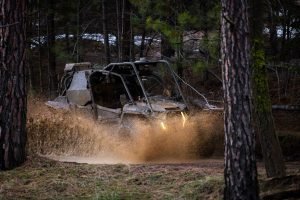
A new crop of early-stage startups — along with some recent VC investments — illustrates a niche emerging in the autonomous vehicle technology sector. Unlike the companies bringing robotaxis to city streets, these startups are taking their tech off-road.
Two recent entrants — Seattle-based Overland AI and New Brunswick-based Potential — are poised to get a first-mover advantage on this segment of autonomy.
While these startups are applying their tech in different ways, Overland AI and Potential do share some common off-road ground. Founders of each startup believe they’ve cracked the code to one of the more challenging applications of automated driving by building software that doesn’t rely on some of the main crutches of testing and deployment — such as detailed maps, large swaths of training data and the ability to fall back on remote assistance.
The U.S. Department of Defense and venture capital investors are taking notice.
Overland AI, which is developing a self-driving system designed for military operations like reconnaissance, surveillance and delivering electronic warfare packages, was awarded in April up to $18.6 million from the U.S. Army’s Defense Innovation Unit. The funds will be used to build a prototype autonomous software stack for its Robotic Combat Vehicle (RCV) program over the next two years.
The startup, which was founded in 2022, raised this week a $10 million seed round led by Point72 Ventures. The funds will be used to expand Overland’s team and continue developing OverDrive, the company’s autonomy stack, according to CEO and founder Byron Boots.
Meanwhile, Potential, which is making advanced driver assistance systems (ADAS) that allows ATVs, underground mining vehicles and passenger cars to handle off-road environments, has raised a $2 million CAD (~$1.5 million USD) extension to its seed round led by Brightspark Ventures, a Canadian early-stage VC. That brings Potential’s total funding to $8.5 million CAD (~$6.2 million USD). The startup has spent the last six years developing its technology and is now doing several pilot projects across power sports, motorcycles and automotive.
Off-road opportunity
Potential and Overland AI aren’t the only companies trying to apply autonomous vehicle technology to areas outside of public streets. The high-cost pursuit of commercial robotaxi and self-driving truck operations has thwarted dozens of startups over the past several years. As those shut down, a new batch of startups such as Polymath Robotics, Forterra, Pronto.ai, Bear Robotics and Outrider have emerged with more grounded ambitions: applying AV tech to warehouses, mining, industrial and off-road environments.
“We are absolutely deploying capital in off-road autonomy,” Alexei Andreev, managing director at Autotech Ventures, told TechCrunch. “Actually, if anything, we are staying away from highway autonomy and completely doubled down on off-road autonomy.”
Most of the off-road companies that Autotech Ventures is investing in today are in the agricultural and construction sectors — products like autonomous mining vehicles, forklifts and tractors. Andreev says for these sectors, it’s about addressing the labor shortage while increasing productivity and making farms and construction areas safer.
“And if you remove people, you immediately get a reduction in your insurance premiums. So the ROI for those vertical applications is now and it’s significant,” said Andreev.
Another upshot: Off-road autonomy has found a friend in defense.
Overland AI: From DARPA to seed funding

When it comes to automating off-road driving, the U.S. Army can be a great customer. After all, autonomous vehicles started as a DARPA project, says Jeff Peters, a partner at Ibex Investors. DARPA (Defense Advanced Research Projects Agency) is a U.S. Department of Defense agency focused on advancing technology for military use.
“The hype around AV moved a lot of the industry toward bigger potential commercial applications, but DoD projects have persisted,” Peters told TechCrunch over email, noting that autonomous mining startup SafeAI and autonomous trucking startup Kodiak Robotics have also pursued defense grants. “I think AV companies (those still around) will chase DoD projects because it offers large, non-dilutive funding in the interim prior to commercial operations.”
Overland AI is the latest byproduct of the DARPA program. Boots, a professor of machine learning at the University of Washington and founder of the Robot Learning Laboratory at the university’s school of computer science and engineering, has a long history of collaborating with the U.S. Army Research Lab and DARPA.
Overland was spun out from Boots’ research and team involved in DARPA’s RACER (Robotic Autonomy in Complex Environments with Resiliency) program, the goal of which is to develop self-driving vehicles that can handle tough terrain.
The program is still ongoing. Overland, which is stacked with deep tech veterans from Google, Nvidia, Apple, Waymo, Aurora, Embark and Argo as well as software engineers who’ve worked on mission-critical solutions at SpaceX, RTX and the U.S. Army, was recently selected to continue on to the second phase.
“The high-level idea is that currently just about every ground vehicle that the military uses has a person inside of it,” Boots told TechCrunch in a video interview. “And you can imagine if you can just pull the person out of the vehicle, that confers safety and tactical advantages.”
To pull the person out means vehicles must autonomously navigate complex off-road terrain using only onboard sensors (mainly cameras, according to Boots) and compute, without relying on maps, GPS or remote human operators. That means Overland’s software has to understand the geometry of the ground — including things like vegetation and mud — every step of the way, and how that affects vehicle dynamics.
“The terrain gets a vote on how the vehicle moves,” said Boots.
Overland’s tech “basically takes in the sensor data and builds a terrain representation as it goes,” Boots explained. Then the vehicle uses that digital representation “plus the goal that it’s trying to get to, which could be several kilometers away, to try to find a route through the terrain towards that goal.”
“Part of the benefit of having an autonomous system is that when the system is tasked, if you lose a communication link to that ground vehicle, it will continue to move towards its goal and try to complete the task until the communication link is reestablished,” said Boots.
Most on-road driving today relies on that telecommunications link to remote assistance, in part because the risk to other road users is higher. That’s why you’ll see Waymo and Cruise robotaxis bricked up on the streets of San Francisco, waiting for a remote operator to give them a nudge after they stopped driving to meet a minimum safety requirement.
“Military ground systems often need to function in unstructured, dynamic terrain. We believe self-driving technology built for well-defined streets and enclosed lots will struggle there, and that it takes a very strong team to deliver operationally relevant ground autonomy in these environments,” Chris Morales, partner on the defense tech team at Point72 Ventures, told TechCrunch.
Potential’s potential with off-road ADAS

“How can you actually enable somebody who maybe isn’t the 100% expert driver, but somebody who wants to go off-roading and experience these more challenging conditions?” Sam Poirier, CEO at Potential, asked in a recent interview.
Potential’s core platform, called Terrain Intelligence, uses computer vision to help vehicles see, interpret and prepare for complex terrain and changing surface conditions ahead. Terrain Intelligence can read data from a single camera, rather than relying on additional sensors like additional cameras, lidar and radar.
At the most basic level, Potential’s off-road ADAS alerts the driver to an impassable object up ahead or the need to switch to a better drive setting based on new terrain.
“The second level is, can we instead actually help to automate the changes of what are typically driver-assisted settings?” said Poirier. “Most vehicles have two-wheel drive, four-wheel drive, sand mode, mud mode, things like that. Ultimately, at this stage, it’s up to the driver to switch between these…and the driver has to understand when to use these different modes.”
Potential’s final level would involve using existing sensor data and fine-tuning those settings and pushing the limits of performance.
“There are things that the assistance tools can do that an individual driver — no matter how good your expertise — cannot do on their own,” said Scott Kunselman, an ex-Jeep chief engineer, auto industry veteran and advisor to Potential. “Stability controls are a good example because to enable stability control, you need independent brake control. The driver only has one brake pedal and actuates the whole brake system at once. Whereas stability control can individually actuate each wheel and that’s how you can produce, for example, the ability to offset yaw in a vehicle.”
Yaw, by the way, is when a vehicle’s weight shifts from its center of gravity to the right or left, which can cause it to spin out or fishtail.
Potential said it’s working with both Tier 1 suppliers and OEMs to license its software and integrate it directly into the vehicles. Andreev suggests Potential focus on business relations with Tier 1 suppliers rather than OEMs that are less likely to take a chance on a small startup.




